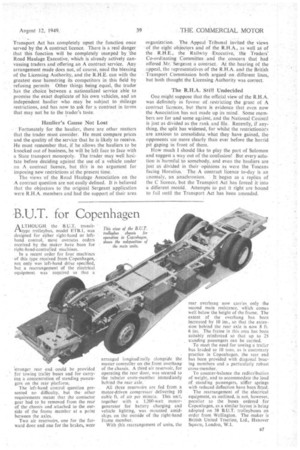B.U.T. for Copenhagen
Page 41

If you've noticed an error in this article please click here to report it so we can fix it.
ALTHOUGH the B.U.T. transit" type trolleybus, model ETB.1, was designed for either right-hand or lefthand control. most overseas orders received by the. maker have been for right-hand-controlled machines.
In a recent order for four machines of this type received from Copenhagen, • . not only was left-hand drive specified, but a rearrangement of the electrical equipment was required so that a
stronger rear end could be provided for towing trailer buses and for carrying a concentration of standing passengers on the rear platform.
The left-hand control question presented no difficulty, but the other requirements meant that the contactor gear had to be removed from the rear of the chassis and attached to the outside of the frame member at a point between the axles.
Two air reservoirs, one for the forward door and one for the brakes, were arranged longitudinally alongside the master controller on the front overhang of the chassis. A third air reservoir, for operating the rear door, was secured to the tubular cross-member immediately behind the rear axle.
All three reservoirs are fed from a motor-driven compressor delivering 10 cubic ft. of air per minute. This unit, together with a 1,200-watt motorgenerator for battery charging and vehicle lighting, was mounted amidships on the outside of the right-hand frame member.
With this rearrangement of units, the rear overhang now carries only the second main resistance,' which comes well below the height of the frame. The extent of the overhang has been increased by 10 ins., so that the extension behind the rear axle is now 8 ft. 6 ins. The frame in this area has been suitably reinforced so that up to 25 standing passengers can be carried.
To meet the need for towing a trailer bus loaded to 10 tons, as is customary practice in Copenhagen, the rear end has been provided with diagonal bracing members and a particularly robust cross-member..
To counter-balance the redistribution of weight. and to accommodate the load of standing passengers, stiffer springs with reduced deflection have been fitted.
The rearrangement of the electrical equipment, as outlined, is not, however, peculiar to the buses ordered for Copenhagen, aS a similar layout is being adopted on 38 BAIT. trolleybuses on order from Wellington. The maker is British United Traction, Ltd., Hanover Square, London, WI.




















































































